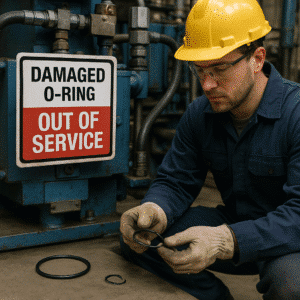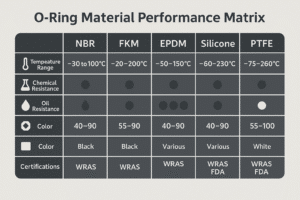Ever replaced a pneumatic seal only to find it failed again within weeks? The culprit could be microscopic dust—something only dust wiper seals can stop.
Dust wiper seals, also known as scraper seals or wipers, remove debris from the piston rod as it retracts into the cylinder. They’re the first line of defense against contamination, wear, and seal failure.
Neglecting this simple component can drastically reduce the lifespan of your pneumatic system. Here’s why wiper seals matter more than you think.
What are dust wiper seals and how do they work?
Think of dust wipers as the gatekeepers of your cylinder. Without them, contaminants enter and destroy internal components.
Dust wiper seals clean the rod surface as it retracts into the pneumatic cylinder, preventing entry of dirt, metal chips, or moisture. They protect inner seals like piston and rod seals from abrasion and clogging.
Key functions of dust wiper seals in pneumatic cylinders
| Function | Impact on Cylinder |
|---|---|
| Remove external debris | Prevents scratches on rod |
| Seal rod entry point | Blocks moisture and particles |
| Protect piston & rod seals | Extends service life |
| Maintain air-tightness | Reduces leakage over time |
Learn how all seals work together in our guide: How to choose the right seal for your pneumatic cylinder.
Why are dust wiper seals essential for pneumatic cylinders?
Skipping a dust seal might seem minor, but it’s a shortcut to early failure. Let me show you how.
Contaminants bypassing the rod area can cause abrasive wear, scratch the piston rod, and damage internal seals. This leads to leakage, poor performance, and costly repairs.
Real-world failure without dust wiper seals
A customer in the textile industry ignored wiper seals in their air cylinders. Within 2 months, fabric fibers caused severe rod scoring, leading to total seal failure and 4X maintenance cost.
How often should dust wiper seals be replaced?
Dust wiper seals endure constant motion and exposure. Routine inspections are vital for reliability.
Check your dust wipers every 6 months for cracking, deformation, or hardening. Replace immediately if signs of damage appear. Preventive replacement extends the lifespan of inner cylinder seals and reduces downtime.
To ensure full kit protection, explore our complete pneumatic cylinder seal kits.
What materials are best for dust wiper seals?
Material matters—dust wipers endure constant exposure to dirt and motion. Choose smart.
For general use, TPU (thermoplastic polyurethane) offers excellent elasticity and abrasion resistance. For high-temperature or chemical environments, FKM and NBR may be used. Dual-lip or metal-cased wipers add durability.
Best materials for dust wiper seals: comparison table
| Material | Advantages | Application Scenario |
|---|---|---|
| TPU | Flexible, tough, low-wear | General purpose, high cycle |
| NBR | Oil-resistant, economical | Mild environments |
| FKM | Heat/chemical resistant | High-temp, aggressive fluids |
Can dust wiper seals be retrofitted without disassembling the cylinder?
In some cases yes, but design matters. Some external-fit designs allow tool-free installation, while others require partial disassembly. Always check with your cylinder OEM or explore compatible wiper seal options from Hengoseal.
Replacing damaged wipers promptly prevents particle ingress and prolongs full system service life.
Are dust wiper seals included in full pneumatic seal kits?
Yes. Hengoseal includes dust wipers in our full pneumatic cylinder seal kits, ensuring piston seals, rod seals, and wipers work in harmony.
This integrated approach reduces sourcing complexity and ensures all components match your cylinder profile.
Conclusion
Dust wiper seals may be small, but they play a huge role in protecting your pneumatic cylinder from dirt, moisture, and premature failure.
Don’t let contamination shorten your system's lifespan
Email: [email protected]
WhatsApp: +86 17622979498
Explore our dust wiper seal solutions now
Related topic
Complete Pneumatic Cylinder Seal Kits
Pneumatic Piston Seal Selection Guide
Reliable Pneumatic Cylinder Seals


